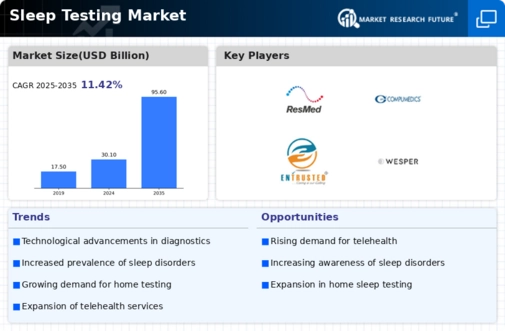Based on the region, the Sleep Testing Market has been segmented into north America, Europe, Asia-Pacific, South America, and Middle East & Africa. North America accounted for the largest market share in 2024.
The Sleep Testing Market in North America is experiencing significant growth, driven by the rising prevalence of sleep disorders like sleep apnea, insomnia, and narcolepsy, as well as increased awareness about the importance of sleep health. For instance, according to the American Sleep Apnea Association, it is estimated that 22 million Americans suffer from sleep apnea, with 80% of moderate and severe cases undiagnosed. This provides a significant opportunity for sleep testing to grow.
With obstructive sleep apnea affecting millions of people, the demand for diagnostic services, such as home sleep apnea tests (HSATs) and in-lab polysomnography (PSG), is on the rise. Technological advancements, including wearable devices and telemedicine, are also playing a crucial role in expanding access to sleep testing. Moreover, an aging population and increasing rates of chronic conditions such as obesity and hypertension are contributing to the growing need for sleep disorder diagnoses. North America's healthcare system, along with government initiatives and insurance reimbursements, further supports market growth by making sleep testing more accessible.
Furthermore, the Sleep Testing Market in Europe is witnessing significant growth, fueled by an increasing awareness of sleep disorders such as sleep apnea, insomnia, and restless leg syndrome, as well as the rising prevalence of conditions linked to poor sleep, including obesity and cardiovascular diseases. For instance, The European Sleep Apnea Group (ESAG) estimates that sleep apnea affects approximately 4% of men and 2% of women in Europe, but only a fraction of those individuals are diagnosed and treated.
Moreover, with over 100 million people affected by sleep apnea in Europe, of which an estimated 80% remain undiagnosed, the demand for both in-lab polysomnography (PSG) and home sleep apnea testing (HSAT) is rapidly rising. Advancements in diagnostic technology, such as home sleep apnea testing (HSAT) and telemedicine, are enhancing accessibility and convenience, enabling patients to seek testing services remotely or at home. This trend is especially prevalent in countries with strong healthcare infrastructures like Germany, France, and the UK, where both in-lab polysomnography (PSG) and home testing are widely available.
Also, the Sleep Testing Market in the Asia-Pacific (APAC) region is expanding rapidly, driven by a combination of rising awareness of sleep disorders, an aging population, and increasing healthcare access. Sleep disorders, particularly sleep apnea, insomnia, and narcolepsy, are becoming more prevalent across APAC due to lifestyle changes, urbanization, and growing levels of stress. The region's diverse population, ranging from highly developed economies like Japan, South Korea, and Australia, to emerging markets in China, India, and Southeast Asia, presents both opportunities and challenges for sleep testing service providers.
The Sleep Testing Market in South America is gradually expanding, fueled by increasing awareness of sleep disorders such as sleep apnea, insomnia, and restless leg syndrome. As the region faces rising obesity rates, urbanization, and stress-related health issues, the demand for sleep diagnostics is growing, particularly in countries like Brazil, Argentina, and Chile.The adoption of home sleep apnea testing (HSAT) is becoming more popular due to its affordability and convenience, while advancements in wearable devices and mobile health apps are further driving interest in sleep disorder diagnosis.
The region’s aging population, particularly in countries like Brazil, is also contributing to the demand for sleep testing, as older adults are more likely to suffer from sleep conditions.
The Middle East & Africa is further segmented into GCC Countries, South Africa, and Rest of Middle East & Africa. Sleep apnea, particularly obstructive sleep apnea (OSA), is one of the primary conditions driving demand for sleep testing in the MEA region. In countries like Saudi Arabia, UAE, and Egypt, obesity, smoking, and air pollution contribute to the rising incidence of sleep apnea. For instance, the UAE has one of the highest obesity rates globally, with 27% of the adult population classified as obese.
Saudi Arabia reports 35% of the population being obese, which further fuels the demand for sleep testing. A significant percentage of the population remains undiagnosed, creating a major market opportunity for diagnostic services. Insomnia is also on the rise due to urbanization, increasing levels of stress, and lifestyle changes. As more people face sleep disturbances, the demand for accurate diagnoses and treatment solutions is growing. UAE and Qatar also report higher-than-average insomnia rates, driven by urban stress and changing lifestyles.
Figure 3: Sleep Testing Market BY REGION 2024 & 2035 (USD Billion)
Source: Secondary Research, Primary Research, MRFR Database, and Analyst Review















Leave a Comment